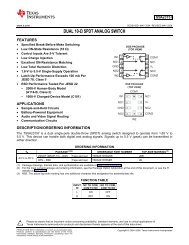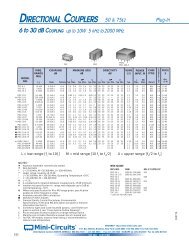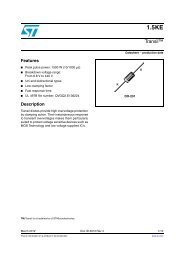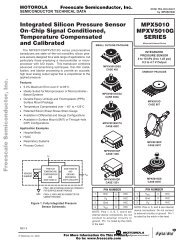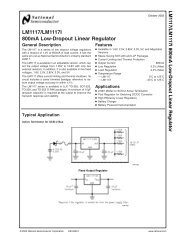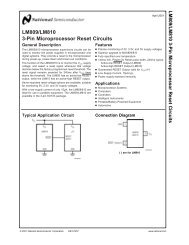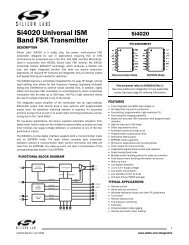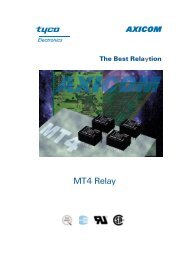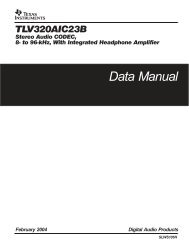FM24V05 - 512Kb I2C FRAM - Ramtron
FM24V05 - 512Kb I2C FRAM - Ramtron
FM24V05 - 512Kb I2C FRAM - Ramtron
Create successful ePaper yourself
Turn your PDF publications into a flip-book with our unique Google optimized e-Paper software.
<strong>FM24V05</strong><br />
<strong>512Kb</strong> Serial 3V F-RAM Memory<br />
Features<br />
512K bit Ferroelectric Nonvolatile RAM<br />
Organized as 65,536 x 8 bits<br />
High Endurance 100 Trillion (10 14 ) Read/Writes<br />
10 year Data Retention<br />
NoDelay Writes<br />
Advanced High-Reliability Ferroelectric Process<br />
Fast Two-wire Serial Interface<br />
Up to 3.4 MHz maximum bus frequency<br />
Direct hardware replacement for EEPROM<br />
Supports legacy timing for 100 kHz & 400 kHz<br />
Device ID and Serial Number<br />
Device ID reads out Manufacturer ID & Part ID<br />
Unique Serial Number (FM24VN05)<br />
Low Voltage, Low Power Operation<br />
Low Voltage Operation 2.0V – 3.6V<br />
Active Current < 150 A (typ. @ 100KHz)<br />
90 A Standby Current (typ.)<br />
5 A Sleep Mode Current (typ.)<br />
Industry Standard Configuration<br />
Industrial Temperature -40 C to +85 C<br />
8-pin “Green”/RoHS SOIC Package<br />
Description<br />
The <strong>FM24V05</strong> is a <strong>512Kb</strong>it nonvolatile memory<br />
employing an advanced ferroelectric process. A<br />
ferroelectric random access memory or F-RAM is<br />
nonvolatile and performs reads and writes like a<br />
RAM. It provides reliable data retention for 10 years<br />
while eliminating the complexities, overhead, and<br />
system level reliability problems caused by<br />
EEPROM and other nonvolatile memories.<br />
The <strong>FM24V05</strong> performs write operations at bus<br />
speed. No write delays are incurred. The next bus<br />
cycle may commence immediately without the need<br />
for data polling. In addition, the product offers write<br />
endurance orders of magnitude higher than<br />
EEPROM. Also, F-RAM exhibits much lower power<br />
during writes than EEPROM since write operations<br />
do not require an internally elevated power supply<br />
voltage for write circuits.<br />
available in industry standard 8-pin SOIC package<br />
using a familiar two-wire (I 2 C) protocol. The<br />
FM24VN05 is offered with a unique serial number<br />
that is read-only and can be used to identify a board<br />
or system. Both devices incorporate a read-only<br />
Device ID that allows the host to determine the<br />
manufacturer, product density, and product revision.<br />
The devices are guaranteed over an industrial<br />
temperature range of -40°C to +85°C.<br />
Pin Configuration<br />
A0<br />
A1<br />
A2<br />
VSS<br />
1<br />
2<br />
3<br />
4<br />
8<br />
7<br />
6<br />
5<br />
VDD<br />
WP<br />
SCL<br />
SDA<br />
These capabilities make the <strong>FM24V05</strong> ideal for<br />
nonvolatile memory applications requiring frequent<br />
or rapid writes. Examples range from data collection<br />
where the number of write cycles may be critical, to<br />
demanding industrial controls where the long write<br />
time of EEPROM can cause data loss. The<br />
combination of features allows more frequent data<br />
writing with less overhead for the system.<br />
The <strong>FM24V05</strong> provides substantial benefits to users<br />
of serial EEPROM, yet these benefits are available in<br />
a hardware drop-in replacement. The devices are<br />
Pin Name<br />
A0-A2<br />
SDA<br />
SCL<br />
WP<br />
VDD<br />
VSS<br />
Function<br />
Device Select Address<br />
Serial Data/address<br />
Serial Clock<br />
Write Protect<br />
Supply Voltage<br />
Ground<br />
This product conforms to specifications per the terms of the <strong>Ramtron</strong><br />
<strong>Ramtron</strong> International Corporation<br />
standard warranty. The product has completed <strong>Ramtron</strong>’s internal 1850 <strong>Ramtron</strong> Drive, Colorado Springs, CO 80921<br />
qualification testing and has reached production status. (800) 545-<strong>FRAM</strong>, (719) 481-7000<br />
Rev. 3.0<br />
http://www.ramtron.com<br />
Jan. 2012 Page 1 of 16
<strong>FM24V05</strong> - <strong>512Kb</strong> <strong>I2C</strong> <strong>FRAM</strong><br />
Counter<br />
Address<br />
Latch<br />
8K x 64<br />
<strong>FRAM</strong> Array<br />
8<br />
SDA<br />
SCL<br />
WP<br />
A0-A2<br />
Serial to Parallel<br />
Converter<br />
Control Logic<br />
Data Latch<br />
8<br />
Device ID and<br />
Serial Number<br />
Figure 1. <strong>FM24V05</strong> Block Diagram<br />
Pin Description<br />
Pin Name Type Pin Description<br />
A0-A2 Input Device Select Address 0-2: These pins are used to select one of up to 8 devices of<br />
the same type on the same two-wire bus. To select the device, the address value on<br />
the two pins must match the corresponding bits contained in the slave address. The<br />
address pins are pulled down internally.<br />
SDA I/O Serial Data/Address: This is a bi-directional pin for the two-wire interface. It is<br />
open-drain and is intended to be wire-OR’d with other devices on the two-wire bus.<br />
The input buffer incorporates a Schmitt trigger for noise immunity and the output<br />
driver includes slope control for falling edges. An external pull-up resistor is<br />
required.<br />
SCL Input Serial Clock: The serial clock pin for the two-wire interface. Data is clocked out of<br />
the part on the falling edge, and into the device on the rising edge. The SCL input<br />
also incorporates a Schmitt trigger input for noise immunity.<br />
WP Input Write Protect: When tied to VDD, addresses in the entire memory map will be writeprotected.<br />
When WP is connected to ground, all addresses may be written. This pin<br />
is pulled down internally.<br />
VDD Supply Supply Voltage<br />
VSS Supply Ground<br />
Rev. 3.0<br />
Jan. 2012 Page 2 of 16
<strong>FM24V05</strong> - <strong>512Kb</strong> <strong>I2C</strong> <strong>FRAM</strong><br />
Overview<br />
The <strong>FM24V05</strong> is a family of serial F-RAM memory<br />
devices. The memory array is logically organized as a<br />
65,536 x 8 bit memory array and is accessed using an<br />
industry standard two-wire (I 2 C) interface. Functional<br />
operation of the F-RAM is similar to serial<br />
EEPROM. The major difference between the<br />
<strong>FM24V05</strong> and serial EEPROM is F-RAM’s superior<br />
write performance.<br />
Memory Architecture<br />
When accessing the <strong>FM24V05</strong>, the user addresses<br />
65,536 locations each with 8 data bits. These data bits<br />
are shifted serially. The 65,536 addresses are<br />
accessed using the two-wire protocol, which includes<br />
a slave address (to distinguish other non-memory<br />
devices) and a 2-byte address. All 16 address bits are<br />
used by the decoder for accessing the memory.<br />
The access time for memory operation is essentially<br />
zero beyond the time needed for the serial protocol.<br />
That is, the memory is read or written at the speed of<br />
the two-wire bus. Unlike an EEPROM, it is not<br />
necessary to poll the device for a ready condition<br />
since writes occur at bus speed. That is, by the time a<br />
new bus transaction can be shifted into the part, a<br />
write operation will be complete. This is explained in<br />
more detail in the interface section below.<br />
Users expect several obvious system benefits from<br />
the <strong>FM24V05</strong> due to its fast write cycle and high<br />
endurance as compared with EEPROM. However<br />
there are less obvious benefits as well. For example<br />
in a high noise environment, the fast-write operation<br />
is less susceptible to corruption than an EEPROM<br />
since it is completed quickly. By contrast, an<br />
EEPROM requiring milliseconds to write is<br />
vulnerable to noise during much of the cycle.<br />
Two-wire Interface<br />
The <strong>FM24V05</strong> employs a bi-directional two-wire bus<br />
protocol using few pins or board space. Figure 2<br />
illustrates a typical system configuration using the<br />
<strong>FM24V05</strong> in a microcontroller-based system. The<br />
industry standard two-wire bus is familiar to many<br />
users but is described in this section.<br />
By convention, any device that is sending data onto<br />
the bus is the transmitter while the target device for<br />
this data is the receiver. The device that is controlling<br />
the bus is the master. The master is responsible for<br />
generating the clock signal for all operations. Any<br />
device on the bus that is being controlled is a slave.<br />
The <strong>FM24V05</strong> always is a slave device.<br />
The bus protocol is controlled by transition states in<br />
the SDA and SCL signals. There are four conditions<br />
including start, stop, data bit, or acknowledge. Figure<br />
3 illustrates the signal conditions that specify the four<br />
states. Detailed timing diagrams are shown in the<br />
electrical specifications section.<br />
Microcontroller<br />
SDA<br />
SCL<br />
<strong>FM24V05</strong><br />
A0 A1 A2<br />
R min = 1.1 Kohm<br />
R max = t R/Cbus<br />
SDA<br />
SCL<br />
<strong>FM24V05</strong><br />
A0 A1 A2<br />
Figure 2. Typical System Configuration<br />
VDD<br />
Note that it is the user’s responsibility to ensure that<br />
V DD is within datasheet tolerances to prevent<br />
incorrect operation.<br />
Rev. 3.0<br />
Jan. 2012 Page 3 of 16
<strong>FM24V05</strong> - <strong>512Kb</strong> <strong>I2C</strong> <strong>FRAM</strong><br />
SCL<br />
SDA<br />
7<br />
6 0<br />
Stop<br />
(Master)<br />
Start<br />
(Master)<br />
Data bits<br />
(Transmitter)<br />
Data bit Acknowledge<br />
(Transmitter) (Receiver)<br />
Figure 3. Data Transfer Protocol<br />
Stop Condition<br />
A stop condition is indicated when the bus master<br />
drives SDA from low to high while the SCL signal is<br />
high. All operations using the <strong>FM24V05</strong> should end<br />
with a stop condition. If an operation is in progress<br />
when a stop is asserted, the operation will be aborted.<br />
The master must have control of SDA (not a memory<br />
read) in order to assert a stop condition.<br />
Start Condition<br />
A start condition is indicated when the bus master<br />
drives SDA from high to low while the SCL signal is<br />
high. All commands should be preceded by a start<br />
condition. An operation in progress can be aborted by<br />
asserting a start condition at any time. Aborting an<br />
operation using the start condition will ready the<br />
<strong>FM24V05</strong> for a new operation.<br />
If during operation the power supply drops below the<br />
specified V DD minimum, the system should issue a<br />
start condition prior to performing another operation.<br />
Data/Address Transfer<br />
All data transfers (including addresses) take place<br />
while the SCL signal is high. Except under the two<br />
conditions described above, the SDA signal should<br />
not change while SCL is high.<br />
Acknowledge<br />
The acknowledge takes place after the 8 th data bit has<br />
been transferred in any transaction. During this state<br />
the transmitter should release the SDA bus to allow<br />
the receiver to drive it. The receiver drives the SDA<br />
signal low to acknowledge receipt of the byte. If the<br />
receiver does not drive SDA low, the condition is a<br />
no-acknowledge and the operation is aborted.<br />
The receiver would fail to acknowledge for two<br />
distinct reasons. First is that a byte transfer fails. In<br />
this case, the no-acknowledge ceases the current<br />
operation so that the part can be addressed again.<br />
This allows the last byte to be recovered in the event<br />
of a communication error.<br />
Second and most common, the receiver does not<br />
acknowledge to deliberately end an operation. For<br />
example, during a read operation, the <strong>FM24V05</strong> will<br />
continue to place data onto the bus as long as the<br />
receiver sends acknowledges (and clocks). When a<br />
read operation is complete and no more data is<br />
needed, the receiver must not acknowledge the last<br />
byte. If the receiver acknowledges the last byte, this<br />
will cause the <strong>FM24V05</strong> to attempt to drive the bus<br />
on the next clock while the master is sending a new<br />
command such as stop.<br />
Slave Address<br />
The first byte that the <strong>FM24V05</strong> expects after a start<br />
condition is the slave address. As shown in Figure 4,<br />
the slave address contains the device type or slave<br />
ID, the device select address bits, a page address bit,<br />
and a bit that specifies if the transaction is a read or a<br />
write.<br />
Bits 7-4 are the device type (slave ID) and should be<br />
set to 1010b for the <strong>FM24V05</strong>. These bits allow other<br />
function types to reside on the 2-wire bus within an<br />
identical address range. Bits 3-1 are the device select<br />
address bits. They must match the corresponding<br />
value on the external address pins to select the<br />
device. Up to eight <strong>FM24V05</strong> devices can reside on<br />
the same two-wire bus by assigning a different<br />
address to each. Bit 0 is the read/write bit. R/W=1<br />
indicates a read operation and R/W=0 indicates a<br />
write operation.<br />
High Speed Mode (HS-mode)<br />
The <strong>FM24V05</strong> supports a 3.4MHz high speed mode.<br />
A master code (0000 1XXXb) must be issued to place<br />
the device into high speed mode. Communication<br />
between master and slave will then be enabled for<br />
speeds up to 3.4MHz. A stop condition will exit HSmode.<br />
Single- and multiple-byte reads and writes are<br />
supported. See Figures 10 and 11 for HS-mode<br />
timings.<br />
Rev. 3.0<br />
Jan. 2012 Page 4 of 16
<strong>FM24V05</strong> - <strong>512Kb</strong> <strong>I2C</strong> <strong>FRAM</strong><br />
Slave ID<br />
Device Select<br />
1 0 1 0 A2 A1 A0 R/W<br />
7 6 5 4 3 2 1 0<br />
Figure 4. Slave Address<br />
Addressing Overview<br />
After the <strong>FM24V05</strong> (as receiver) acknowledges the<br />
slave address, the master can place the memory<br />
address on the bus for a write operation. The address<br />
requires two bytes. The complete 16-bit address is<br />
latched internally. Each access causes the latched<br />
address value to be incremented automatically. The<br />
current address is the value that is held in the latch --<br />
either a newly written value or the address following<br />
the last access. The current address will be held for as<br />
long as power remains or until a new value is written.<br />
Reads always use the current address. A random read<br />
address can be loaded by beginning a write operation<br />
as explained below.<br />
After transmission of each data byte, just prior to the<br />
acknowledge, the <strong>FM24V05</strong> increments the internal<br />
address latch. This allows the next sequential byte to<br />
be accessed with no additional addressing. After the<br />
last address (FFFFh) is reached, the address latch will<br />
roll over to 0000h. There is no limit to the number of<br />
bytes that can be accessed with a single read or write<br />
operation.<br />
Data Transfer<br />
After the address information has been transmitted,<br />
data transfer between the bus master and the<br />
<strong>FM24V05</strong> can begin. For a read operation the<br />
<strong>FM24V05</strong> will place 8 data bits on the bus then wait<br />
for an acknowledge from the master. If the<br />
acknowledge occurs, the <strong>FM24V05</strong> will transfer the<br />
next sequential byte. If the acknowledge is not sent,<br />
the <strong>FM24V05</strong> will end the read operation. For a write<br />
operation, the <strong>FM24V05</strong> will accept 8 data bits from<br />
the master then send an acknowledge. All data<br />
transfer occurs MSB (most significant bit) first.<br />
Memory Operation<br />
The <strong>FM24V05</strong> is designed to operate in a manner<br />
very similar to other 2-wire interface memory<br />
products. The major differences result from the<br />
higher performance write capability of F-RAM<br />
technology. These improvements result in some<br />
differences between the <strong>FM24V05</strong> and a similar<br />
configuration EEPROM during writes. The complete<br />
operation for both writes and reads is explained<br />
below.<br />
Write Operation<br />
All writes begin with a slave address, then a memory<br />
address. The bus master indicates a write operation<br />
by setting the LSB of the slave address (R/W bit) to a<br />
‘0’. After addressing, the bus master sends each byte<br />
of data to the memory and the memory generates an<br />
acknowledge condition. Any number of sequential<br />
bytes may be written. If the end of the address range<br />
is reached internally, the address counter will wrap<br />
from FFFFh to 0000h.<br />
Unlike other nonvolatile memory technologies, there<br />
is no effective write delay with F-RAM. Since the<br />
read and write access times of the underlying<br />
memory are the same, the user experiences no delay<br />
through the bus. The entire memory cycle occurs in<br />
less time than a single bus clock. Therefore, any<br />
operation including read or write can occur<br />
immediately following a write. Acknowledge polling,<br />
a technique used with EEPROMs to determine if a<br />
write is complete is unnecessary and will always<br />
return a ready condition.<br />
Internally, an actual memory write occurs after the 8 th<br />
data bit is transferred. It will be complete before the<br />
acknowledge is sent. Therefore, if the user desires to<br />
abort a write without altering the memory contents,<br />
this should be done using start or stop condition prior<br />
to the 8 th data bit. The <strong>FM24V05</strong> uses no page<br />
buffering.<br />
The memory array can be write-protected using the<br />
WP pin. This feature is available only on <strong>FM24V05</strong><br />
and FM24VN05 devices. Setting the WP pin to a<br />
high condition (V DD ) will write-protect all addresses.<br />
The <strong>FM24V05</strong> will not acknowledge data bytes that<br />
are written to protected addresses. In addition, the<br />
address counter will not increment if writes are<br />
attempted to these addresses. Setting WP to a low<br />
state (V SS ) will deactivate this feature. WP is pulled<br />
down internally.<br />
Figures 5 and 6 below illustrate a single-byte and<br />
multiple-byte write cycles.<br />
Rev. 3.0<br />
Jan. 2012 Page 5 of 16
<strong>FM24V05</strong> - <strong>512Kb</strong> <strong>I2C</strong> <strong>FRAM</strong><br />
By Master<br />
Start Address & Data Stop<br />
S<br />
Slave Address 0 A Address MSB A Address LSB A Data Byte A P<br />
By <strong>FM24V05</strong><br />
Acknowledge<br />
Figure 5. Single Byte Write<br />
By Master<br />
Start<br />
Address & Data<br />
Stop<br />
S<br />
Slave Address 0 A Address MSB A Address LSB A Data Byte A Data Byte A P<br />
By <strong>FM24V05</strong><br />
Acknowledge<br />
Figure 6. Multiple Byte Write<br />
Read Operation<br />
There are two basic types of read operations. They<br />
are current address read and selective address read. In<br />
a current address read, the <strong>FM24V05</strong> uses the<br />
internal address latch to supply the address. In a<br />
selective read, the user performs a procedure to set<br />
the address to a specific value.<br />
Current Address & Sequential Read<br />
As mentioned above the <strong>FM24V05</strong> uses an internal<br />
latch to supply the address for a read operation. A<br />
current address read uses the existing value in the<br />
address latch as a starting place for the read<br />
operation. The system reads from the address<br />
immediately following that of the last operation.<br />
To perform a current address read, the bus master<br />
supplies a slave address with the LSB set to a ‘1’.<br />
This indicates that a read operation is requested.<br />
After receiving the complete slave address, the<br />
<strong>FM24V05</strong> will begin shifting out data from the<br />
current address on the next clock. The current address<br />
is the value held in the internal address latch.<br />
Beginning with the current address, the bus master<br />
can read any number of bytes. Thus, a sequential read<br />
is simply a current address read with multiple byte<br />
transfers. After each byte the internal address counter<br />
will be incremented.<br />
Each time the bus master acknowledges a byte,<br />
this indicates that the <strong>FM24V05</strong> should read out<br />
the next sequential byte.<br />
There are four ways to properly terminate a read<br />
operation. Failing to properly terminate the read will<br />
most likely create a bus contention as the <strong>FM24V05</strong><br />
attempts to read out additional data onto the bus. The<br />
four valid methods are:<br />
1. The bus master issues a no-acknowledge in the<br />
9 th clock cycle and a stop in the 10 th clock cycle.<br />
This is illustrated in the diagrams below. This is<br />
preferred.<br />
2. The bus master issues a no-acknowledge in the<br />
9 th clock cycle and a start in the 10 th .<br />
3. The bus master issues a stop in the 9 th clock<br />
cycle.<br />
4. The bus master issues a start in the 9 th clock<br />
cycle.<br />
If the internal address reaches FFFFh, it will wrap<br />
around to 0000h on the next read cycle. Figures 7 and<br />
8 below show the proper operation for current<br />
address reads.<br />
Selective (Random) Read<br />
There is a simple technique that allows a user to<br />
select a random address location as the starting point<br />
for a read operation. This involves using the first<br />
three bytes of a write operation to set the internal<br />
address followed by subsequent read operations.<br />
To perform a selective read, the bus master sends out<br />
the slave address with the LSB set to 0. This specifies<br />
a write operation. According to the write protocol,<br />
the bus master then sends the address bytes that are<br />
loaded into the internal address latch. After the<br />
<strong>FM24V05</strong> acknowledges the address, the bus master<br />
Rev. 3.0<br />
Jan. 2012 Page 6 of 16
<strong>FM24V05</strong> - <strong>512Kb</strong> <strong>I2C</strong> <strong>FRAM</strong><br />
issues a start condition. This simultaneously aborts<br />
the write operation and allows the read command to<br />
be issued with the slave address LSB set to a ‘1’. The<br />
operation is now a current address read.<br />
By Master<br />
Start<br />
Address<br />
No<br />
Acknowledge<br />
Stop<br />
S<br />
Slave Address 1 A Data Byte 1 P<br />
By <strong>FM24V05</strong><br />
Acknowledge<br />
Data<br />
Figure 7. Current Address Read<br />
By Master<br />
Start<br />
Address<br />
Acknowledge<br />
No<br />
Acknowledge<br />
Stop<br />
S<br />
Slave Address 1 A Data Byte A Data Byte 1 P<br />
By <strong>FM24V05</strong><br />
Acknowledge<br />
Data<br />
Figure 8. Sequential Read<br />
By Master<br />
Start<br />
Address<br />
Start<br />
Address<br />
No<br />
Acknowledge<br />
Stop<br />
S<br />
Slave Address 0 A Address MSB A<br />
Address LSB<br />
A<br />
S<br />
Slave Address 1 A Data Byte 1 P<br />
By <strong>FM24V05</strong><br />
Acknowledge<br />
Data<br />
Figure 9. Selective (Random) Read<br />
By Master<br />
Start<br />
HS-mode command<br />
S 0 0 0 0 1 X X X 1<br />
Start &<br />
Enter HS-mode Address<br />
S<br />
No<br />
Acknowledge<br />
Slave Address 1 A Data Byte 1 P<br />
Stop &<br />
Exit HS-mode<br />
By <strong>FM24V05</strong><br />
No<br />
Acknowledge<br />
Acknowledge<br />
Data<br />
Figure 10. HS-mode Current Address Read<br />
By Master<br />
Start<br />
HS-mode command<br />
Start &<br />
Enter HS-mode<br />
Address & Data<br />
Stop &<br />
Exit HS-mode<br />
S 0 0 0 0 1 X X X 1<br />
S<br />
Slave Address 0 A Address MSB A Address LSB A Data Byte A P<br />
By <strong>FM24V05</strong><br />
No<br />
Acknowledge<br />
Figure 11. HS-mode Byte Write<br />
Acknowledge<br />
Rev. 3.0<br />
Jan. 2012 Page 7 of 16
<strong>FM24V05</strong> - <strong>512Kb</strong> <strong>I2C</strong> <strong>FRAM</strong><br />
Sleep Mode<br />
A low power mode called Sleep Mode is<br />
implemented on both <strong>FM24V05</strong> and FM24VN05<br />
devices. The device will enter this low power state<br />
when the Sleep command 86h is clocked-in. Sleep<br />
Mode entry can be entered as follows:<br />
1. The master sends a START command.<br />
2. The master sends Reserved Slave ID 0xF8<br />
3. The master sends the I 2 C-bus slave address of<br />
the slave device it needs to identify. The last<br />
bit is a ‘Don’t care’ value (R/W bit). Only one<br />
device must acknowledge this byte (the one<br />
that has the I 2 C-bus slave address).<br />
4. The master sends a Re-START command.<br />
5. The master sends Reserved Slave ID 0x86<br />
6. The <strong>FM24V05</strong> sends an ACK.<br />
7. The master sends STOP to ensure the device<br />
enters sleep mode.<br />
Once in sleep mode, the device draws I ZZ current, but<br />
the device continues to monitor the I 2 C pins. Once<br />
the master sends a Slave Address that the <strong>FM24V05</strong><br />
identifies, it will “wakeup” and be ready for normal<br />
operation within t REC (400 s max.). As an alternative<br />
method of determining when the device is ready, the<br />
master can send read or write commands and look for<br />
an ACK. While the device is waking up, it will<br />
NACK the master until it is ready.<br />
By Master<br />
Start<br />
Address<br />
Start Address Stop<br />
S<br />
Rsvd Slave ID (F8) A Slave Address X A<br />
S Rsvd Slave ID (86) A P<br />
By <strong>FM24V05</strong><br />
Acknowledge<br />
Figure 12. Sleep Mode Entry<br />
Rev. 3.0<br />
Jan. 2012 Page 8 of 16
<strong>FM24V05</strong> - <strong>512Kb</strong> <strong>I2C</strong> <strong>FRAM</strong><br />
Device ID<br />
The <strong>FM24V05</strong> and FM24VN05 devices incorporate a<br />
means of identifying the device by providing three<br />
bytes of data, which are manufacturer, product ID,<br />
and die revision. The Device ID is read-only. It can<br />
be accessed as follows:<br />
1. The master sends a START command.<br />
2. The master sends Reserved Slave ID 0xF8<br />
3. The master sends the I 2 C-bus slave address<br />
of the slave device it needs to identify. The<br />
last bit is a ‘Don’t care’ value (R/W bit).<br />
Only one device must acknowledge this byte<br />
(the one that has the I 2 C-bus slave address).<br />
4. The master sends a Re-START command.<br />
5. The master sends Reserved Slave ID 0xF9<br />
6. The Device ID Read can be done, starting<br />
with the 12 manufacturer bits, followed by<br />
the 9 part identification bits, and then the 3<br />
die revision bits.<br />
7. The master ends the Device ID read<br />
sequence by NACKing the last byte, thus<br />
resetting the slave device state machine and<br />
allowing the master to send the STOP<br />
command.<br />
Note: The reading of the Device ID can be stopped<br />
anytime by sending a NACK command.<br />
By Master<br />
Start<br />
Address<br />
Start<br />
Address<br />
Acknowledge<br />
No<br />
Acknowledge<br />
Stop<br />
S<br />
Rsvd Slave ID (F8) A Slave Address A<br />
S<br />
Rsvd Slave ID (F9) A Data Byte A Data Byte A Data Byte 1 P<br />
By <strong>FM24V05</strong><br />
Acknowledge<br />
Figure 13. Read Device ID<br />
Data<br />
Manufacturer ID Product ID Die Rev.<br />
11 10 9 8 7 6 5 4 3 2 1 0 8 7 6 5 4 3 2 1 0 2 1 0<br />
<strong>Ramtron</strong> Density Variation<br />
0 0 0 0 0 0 0 0 0 1 0 0 0 0 1 1 N 0 0 0 0 0 0 0<br />
Figure 14. Manufacturer and Product ID<br />
Density: 01h=128Kb, 02h=256Kb, 03h=<strong>512Kb</strong>, 04=1Mb<br />
Variation: Product ID bit 4 = S/N, Product ID bit 0 = reserved<br />
The 3-byte hex code for an <strong>FM24V05</strong> will be:<br />
The 3-byte hex code for an FM24VN05 will be:<br />
0x00 0x43 0x00<br />
0x00 0x43 0x80<br />
Rev. 3.0<br />
Jan. 2012 Page 9 of 16
<strong>FM24V05</strong> - <strong>512Kb</strong> <strong>I2C</strong> <strong>FRAM</strong><br />
Unique Serial Number (FM24VN05 only)<br />
The FM24VN05 device also incorporates a read-only<br />
8-byte serial number. It can be used to uniquely<br />
identify a pc board or system. The serial number<br />
includes a 40-bit unique number, an 8-bit CRC, and a<br />
16-bit number that can be defined upon request by<br />
the customer. If a customer-specific number is not<br />
requested, the 16-bit Customer Identifier is 0x0000.<br />
The 8 bytes of data are accessed via a Slave Address<br />
sequence similar to the Device ID. The serial number<br />
can be read by the system as follows:<br />
1. The master sends a START command<br />
2. The master sends Reserved Slave ID 0xF8<br />
3. The master sends the I 2 C-bus slave address of<br />
the slave device it needs to identify. The last<br />
two bits are ‘Don’t care’ values. Only one<br />
device must acknowledge this byte (the one<br />
that has the I 2 C-bus slave address).<br />
4. The master sends a Re-START command<br />
5. The master sends Reserved Slave ID 0xCD to<br />
read the serial number.<br />
6. The master ends the serial number read<br />
sequence by NACKing the last byte, thus<br />
resetting the slave device state machine and<br />
allowing the master to send the STOP<br />
command.<br />
The 8-bit CRC value can be used to compare to the<br />
value calculated by the controller. If the two values<br />
match, then the communication between slave and<br />
master was performed without errors. The function<br />
(shown below) is used to calculate the CRC value.<br />
To perform the calculation, 7 bytes of data are filled<br />
into a memory buffer in the same order as they are<br />
read from the part – i.e. byte7, byte6, byte5, byte4,<br />
byte3, byte2, byte1 of the serial number. The<br />
calculation is performed on the 7 bytes, and the result<br />
should match the final byte out from the part which is<br />
byte0, the 8-bit CRC value.<br />
CUSTOMER IDENTIFIER * 40-bit UNIQUE NUMBER 8-bit CRC<br />
SN(63:56) SN(55:48) SN(47:40) SN(39:32) SN(31:24) SN(23:16) SN(15:8) SN(7:0)<br />
* Contact factory for requesting a customer identifier number.<br />
Figure 15. 8-Byte Serial Number (read-only)<br />
By Master<br />
Start<br />
Address<br />
Start<br />
Address<br />
Acknowledge<br />
No<br />
Acknowledge<br />
Stop<br />
S<br />
Rsvd Slave ID (F8) A Slave Address A<br />
S<br />
Rsvd Slave ID (CD) A Data Byte 7 A<br />
A Data Byte 0 1 P<br />
By FM24VN05<br />
Acknowledge<br />
Figure 16. Read Serial Number<br />
Data<br />
Function to Calculate CRC<br />
BYTE calcCRC8( BYTE* pData, int nBytes )<br />
{<br />
static BYTE crctable[256] = {<br />
0x00, 0x07, 0x0E, 0x09, 0x1C, 0x1B, 0x12, 0x15,<br />
0x38, 0x3F, 0x36, 0x31, 0x24, 0x23, 0x2A, 0x2D,<br />
0x70, 0x77, 0x7E, 0x79, 0x6C, 0x6B, 0x62, 0x65,<br />
0x48, 0x4F, 0x46, 0x41, 0x54, 0x53, 0x5A, 0x5D,<br />
0xE0, 0xE7, 0xEE, 0xE9, 0xFC, 0xFB, 0xF2, 0xF5,<br />
0xD8, 0xDF, 0xD6, 0xD1, 0xC4, 0xC3, 0xCA, 0xCD,<br />
0x90, 0x97, 0x9E, 0x99, 0x8C, 0x8B, 0x82, 0x85,<br />
0xA8, 0xAF, 0xA6, 0xA1, 0xB4, 0xB3, 0xBA, 0xBD,<br />
0xC7, 0xC0, 0xC9, 0xCE, 0xDB, 0xDC, 0xD5, 0xD2,<br />
0xFF, 0xF8, 0xF1, 0xF6, 0xE3, 0xE4, 0xED, 0xEA,<br />
0xB7, 0xB0, 0xB9, 0xBE, 0xAB, 0xAC, 0xA5, 0xA2,<br />
0x8F, 0x88, 0x81, 0x86, 0x93, 0x94, 0x9D, 0x9A,<br />
0x27, 0x20, 0x29, 0x2E, 0x3B, 0x3C, 0x35, 0x32,<br />
0x1F, 0x18, 0x11, 0x16, 0x03, 0x04, 0x0D, 0x0A,<br />
0x57, 0x50, 0x59, 0x5E, 0x4B, 0x4C, 0x45, 0x42,<br />
Rev. 3.0<br />
Jan. 2012 Page 10 of 16
<strong>FM24V05</strong> - <strong>512Kb</strong> <strong>I2C</strong> <strong>FRAM</strong><br />
};<br />
0x6F, 0x68, 0x61, 0x66, 0x73, 0x74, 0x7D, 0x7A,<br />
0x89, 0x8E, 0x87, 0x80, 0x95, 0x92, 0x9B, 0x9C,<br />
0xB1, 0xB6, 0xBF, 0xB8, 0xAD, 0xAA, 0xA3, 0xA4,<br />
0xF9, 0xFE, 0xF7, 0xF0, 0xE5, 0xE2, 0xEB, 0xEC,<br />
0xC1, 0xC6, 0xCF, 0xC8, 0xDD, 0xDA, 0xD3, 0xD4,<br />
0x69, 0x6E, 0x67, 0x60, 0x75, 0x72, 0x7B, 0x7C,<br />
0x51, 0x56, 0x5F, 0x58, 0x4D, 0x4A, 0x43, 0x44,<br />
0x19, 0x1E, 0x17, 0x10, 0x05, 0x02, 0x0B, 0x0C,<br />
0x21, 0x26, 0x2F, 0x28, 0x3D, 0x3A, 0x33, 0x34,<br />
0x4E, 0x49, 0x40, 0x47, 0x52, 0x55, 0x5C, 0x5B,<br />
0x76, 0x71, 0x78, 0x7F, 0x6A, 0x6D, 0x64, 0x63,<br />
0x3E, 0x39, 0x30, 0x37, 0x22, 0x25, 0x2C, 0x2B,<br />
0x06, 0x01, 0x08, 0x0F, 0x1A, 0x1D, 0x14, 0x13,<br />
0xAE, 0xA9, 0xA0, 0xA7, 0xB2, 0xB5, 0xBC, 0xBB,<br />
0x96, 0x91, 0x98, 0x9F, 0x8A, 0x8D, 0x84, 0x83,<br />
0xDE, 0xD9, 0xD0, 0xD7, 0xC2, 0xC5, 0xCC, 0xCB,<br />
0xE6, 0xE1, 0xE8, 0xEF, 0xFA, 0xFD, 0xF4, 0xF3<br />
}<br />
BYTE crc = 0;<br />
while( nBytes-- ) crc = crctable[crc ^ *pData++];<br />
return crc;<br />
Rev. 3.0<br />
Jan. 2012 Page 11 of 16
<strong>FM24V05</strong> - <strong>512Kb</strong> <strong>I2C</strong> <strong>FRAM</strong><br />
Electrical Specifications<br />
Absolute Maximum Ratings<br />
Symbol Description Ratings<br />
V DD Power Supply Voltage with respect to V SS -1.0V to +4.5V<br />
V IN Voltage on any pin with respect to V SS -1.0V to +4.5V<br />
and V IN < V DD +1.0V *<br />
T STG Storage Temperature -55C to +125C<br />
T LEAD Lead Temperature (Soldering, 10 seconds) 260 C<br />
V ESD<br />
Electrostatic Discharge Voltage<br />
- Human Body Model (AEC-Q100-002 Rev. E)<br />
- Charged Device Model (AEC-Q100-011 Rev. B)<br />
- Machine Model (AEC-Q100-003 Rev. E)<br />
Package Moisture Sensitivity Level<br />
2.5kV<br />
1.25kV<br />
200V<br />
MSL-1<br />
* Exception: The “V IN < V DD+1.0V” restriction does not apply to the SCL and SDA inputs.<br />
Stresses above those listed under Absolute Maximum Ratings may cause permanent damage to the device. This is a stress rating<br />
only, and the functional operation of the device at these or any other conditions above those listed in the operational section of this<br />
specification is not implied. Exposure to absolute maximum ratings conditions for extended periods may affect device reliability.<br />
DC Operating Conditions (T A = -40 C to + 85 C, V DD =2.0V to 3.6V unless otherwise specified)<br />
Symbol Parameter Min Typ Max Units Notes<br />
V DD Main Power Supply 2.0 3.3 3.6 V<br />
I DD<br />
V DD Supply Current<br />
@ SCL = 100 kHz<br />
@ SCL = 1 MHz<br />
@ SCL = 3.4 MHz<br />
175<br />
400<br />
1000<br />
I SB Standby Current 90 150 A 2<br />
I ZZ Sleep Mode Current 5 8 A 2<br />
I LI Input Leakage Current ±1 A 3<br />
I LO Output Leakage Current ±1 A 3<br />
V IL Input Low Voltage -0.3 0.3 V DD V<br />
V IH Input High Voltage 0.7 V DD V DD + 0.3 V<br />
V OL1 Output Low Voltage (I OL = 2 mA, V DD ≥ 2.7V) 0.4 V<br />
V OL2 Output Low Voltage (I OL = 150 A) 0.2 V<br />
R IN<br />
Address Input Resistance (WP, A2-A0)<br />
For V IN = V IL (max)<br />
For V IN = V IH (min)<br />
Notes<br />
1. SCL toggling between V DD -0.2V and V SS , other inputs V SS or V DD -0.2V.<br />
2. SCL = SDA = V DD . All inputs V SS or V DD . Stop command issued.<br />
3. VIN or VOUT = V SS to V DD . Does not apply to WP, A2-A0 pins.<br />
4. The input pull-down circuit is stronger (50K) when the input voltage is below V IL and weak (1M) when the input voltage<br />
is above V IH .<br />
50<br />
1<br />
A<br />
A<br />
A<br />
K<br />
M<br />
1<br />
4<br />
Rev. 3.0<br />
Jan. 2012 Page 12 of 16
<strong>FM24V05</strong> - <strong>512Kb</strong> <strong>I2C</strong> <strong>FRAM</strong><br />
AC Parameters (T A = -40 C to + 85 C, V DD =2.0V to 3.6V unless otherwise specified)<br />
F/S-mode<br />
(C L
AC Test Conditions<br />
Input Pulse Levels<br />
Input rise and fall times<br />
Input and output timing levels<br />
0.1 V DD to 0.9 V DD<br />
10 ns<br />
0.5 V DD<br />
<strong>FM24V05</strong> - <strong>512Kb</strong> <strong>I2C</strong> <strong>FRAM</strong><br />
Equivalent AC Test Load Circuit<br />
3.6V<br />
Diagram Notes<br />
All start and stop timing parameters apply to both read and write cycles.<br />
Clock specifications are identical for read and write cycles. Write<br />
timing parameters apply to slave address, word address, and write data<br />
bits. Functional relationships are illustrated in the relevant datasheet<br />
sections. These diagrams illustrate the timing parameters only.<br />
Output<br />
1.8 Kohm<br />
100 pF<br />
Read Bus Timing<br />
SCL<br />
SDA<br />
t SU:SDA<br />
t R<br />
`<br />
t F<br />
t BUF<br />
t HIGH<br />
1/fSCL<br />
t LOW<br />
t SP t SP<br />
t HD:DAT<br />
t SU:DAT<br />
Start<br />
Stop Start<br />
t AA<br />
t DH<br />
Acknowledge<br />
Write Bus Timing<br />
SCL<br />
t HD:DAT<br />
t HD:STA<br />
t SU:DAT<br />
t AA<br />
SDA<br />
t SU:STO<br />
Start Stop Start Acknowledge<br />
Data Retention (T A = -40 C to +85 C)<br />
Parameter Min Max Units Notes<br />
Data Retention 10 - Years<br />
Rev. 3.0<br />
Jan. 2012 Page 14 of 16
<strong>FM24V05</strong> - <strong>512Kb</strong> <strong>I2C</strong> <strong>FRAM</strong><br />
Mechanical Drawing<br />
8-pin SOIC (JEDEC Standard MS-012 variation AA)<br />
Recommended PCB Footprint<br />
3.90 ±0.10 6.00 ±0.20<br />
3.70<br />
7.70<br />
Pin 1<br />
2.00<br />
1.27<br />
0.65<br />
4.90 ±0.10<br />
1.35<br />
1.75<br />
0.25<br />
0.50<br />
45<br />
0.19<br />
0.25<br />
1.27 0.10 mm<br />
0.10<br />
0.33 0.25<br />
0.51<br />
0 - 8<br />
0.40<br />
1.27<br />
Refer to JEDEC MS-012 for complete dimensions and notes.<br />
All dimensions in millimeters.<br />
SOIC Package Marking Scheme<br />
XXXXXX-P<br />
RLLLLLLL<br />
RICYYWW<br />
Legend:<br />
XXXXX= part number, P=package type<br />
R=rev code, LLLLLLL= lot code<br />
RIC=<strong>Ramtron</strong> Int’l Corp, YY=year, WW=work week<br />
Example: <strong>FM24V05</strong>, “Green”/RoHS SOIC package,<br />
Rev. A, Lot 9646447, Year 2010, Work Week 11<br />
Without S/N feature<br />
<strong>FM24V05</strong>-G<br />
A9646447<br />
RIC1011<br />
With S/N feature<br />
FM24VN05-G<br />
A9646447<br />
RIC1011<br />
Rev. 3.0<br />
Jan. 2012 Page 15 of 16
<strong>FM24V05</strong> - <strong>512Kb</strong> <strong>I2C</strong> <strong>FRAM</strong><br />
Revision History<br />
Revision Date Summary<br />
1.0 8/22/2008 Initial Release<br />
1.1 2/2/2009 Added tape and reel ordering information.<br />
2.0 5/25/2010 Changed to Pre-Production status. Updated ESD ratings. Changed part<br />
marking scheme. Expanded CRC check description.<br />
2.1 11/22/2011 Removed S/N option.<br />
3.0 1/30/2012 Changed to Production status.<br />
Ordering Information<br />
Part Number Features Operating Package<br />
Voltage<br />
<strong>FM24V05</strong>-G Device ID 2.0-3.6V 8-pin “Green”/RoHS SOIC<br />
FM24VN05-G Device ID, S/N 2.0-3.6V 8-pin “Green”/RoHS SOIC<br />
<strong>FM24V05</strong>-GTR Device ID 2.0-3.6V 8-pin “Green”/RoHS SOIC,<br />
Tape & Reel<br />
FM24VN05-GTR Device ID, S/N 2.0-3.6V 8-pin “Green”/RoHS SOIC,<br />
Tape & Reel<br />
Rev. 3.0<br />
Jan. 2012 Page 16 of 16



